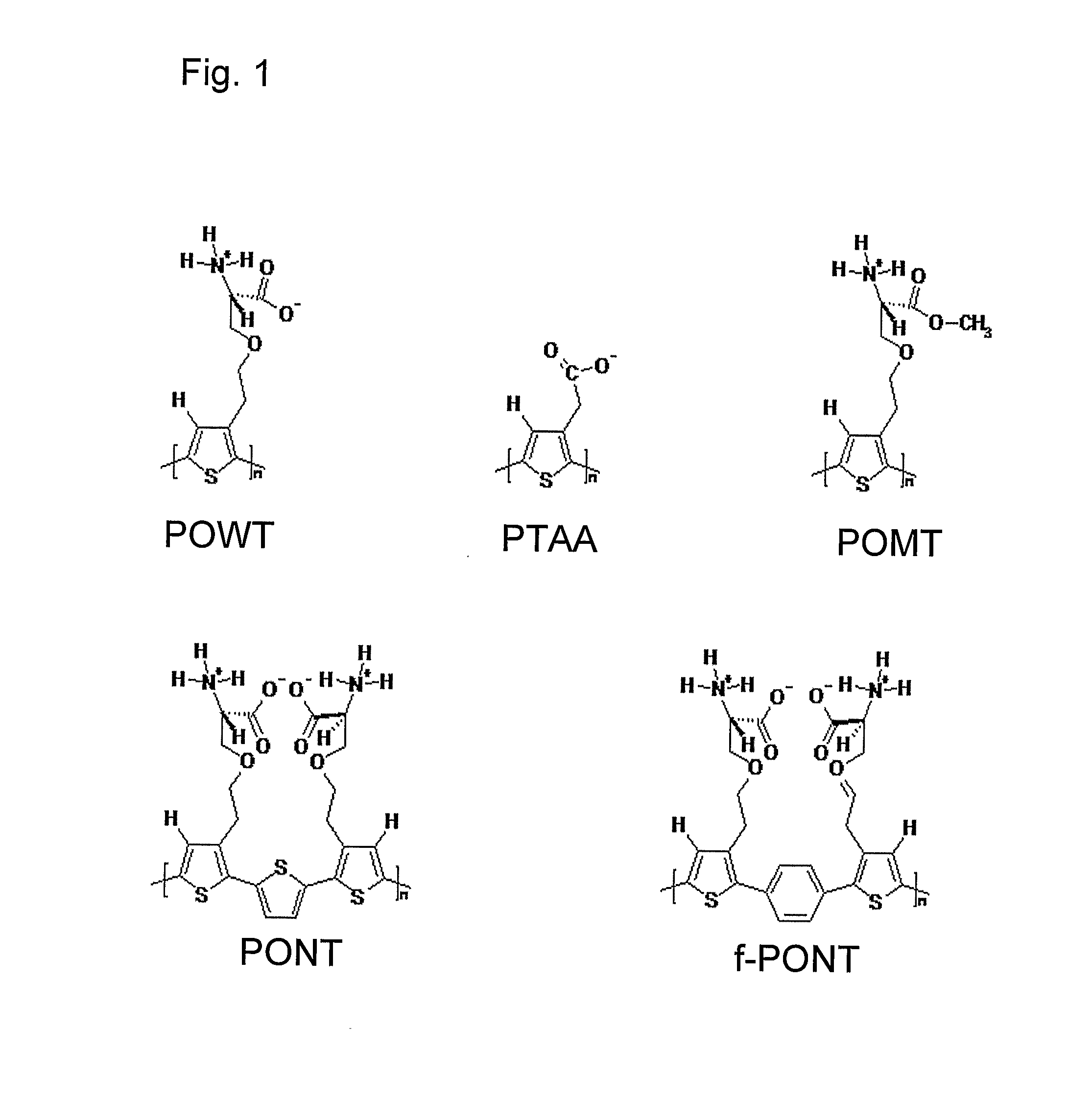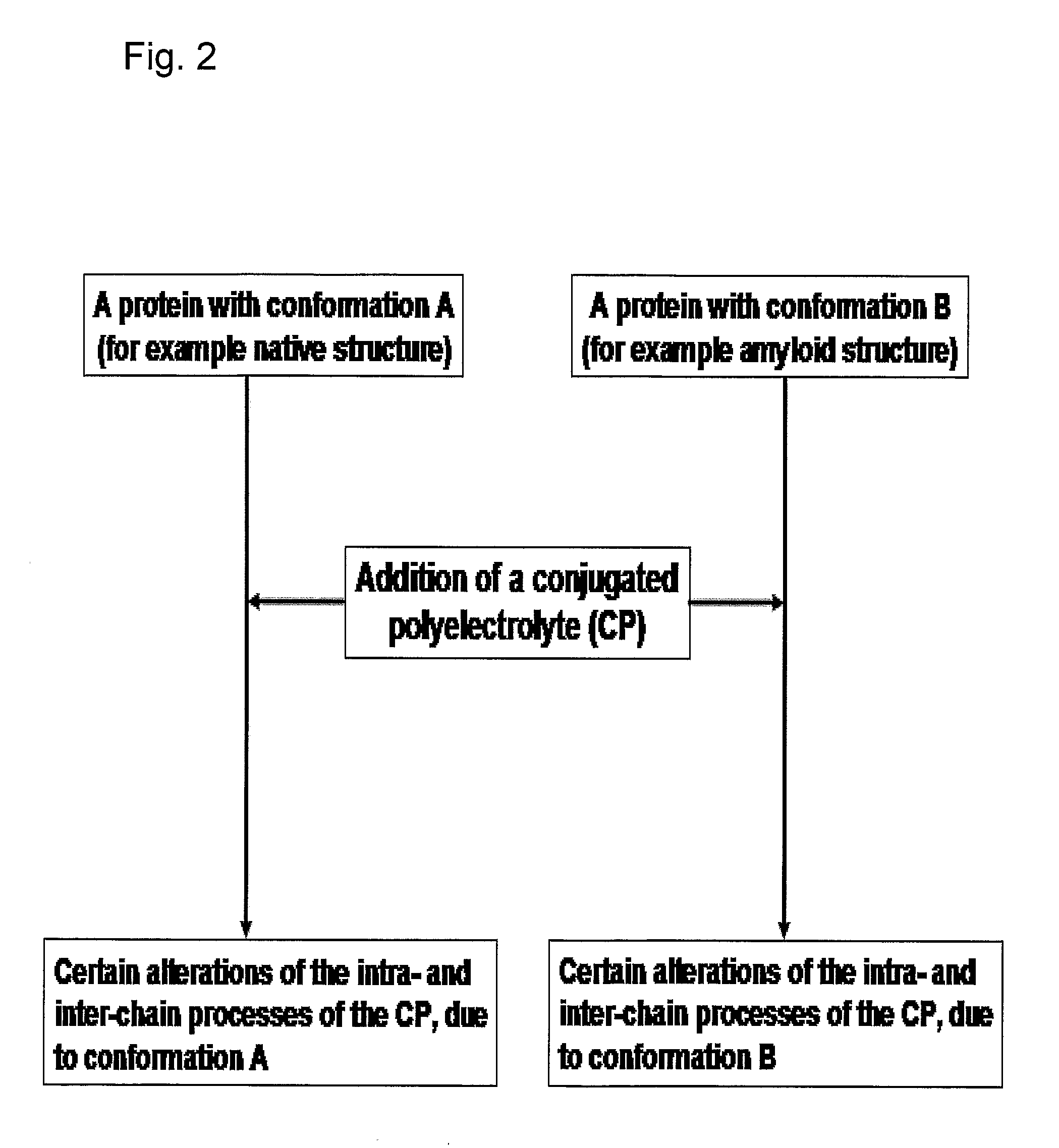Methods for Determining Conformational Changes and Self-Assembly of Proteins
a technology of which is applied in the direction of biochemistry equipment, biochemistry apparatus and processes, material testing goods, etc., can solve the problems of direct probes using cps for recording conformational changes and self-assembly/aggregation of proteins, which have never been reported
- Summary
- Abstract
- Description
- Claims
- Application Information
AI Technical Summary
Benefits of technology
Problems solved by technology
Method used
Image
Examples
example 1
Optical Detection of Amyloid Formation of Bovine Insulin in Solution, Using PTAA
[0072] A stock-solution containing 1.0 mg PTAA / ml in deionized water was prepared. A stock solution containing 320 μM bovine insulin in 25 mM HCl was placed in a water bath (65° C.) to induce the amyloid formation. For the absorption measurements 10 μl of the polymer stock-solution was mixed with 25 μl of the insulin stock-solution, and diluted to a final volume of 1500 μl with 20 mM Na-phosphate pH 7.0. After 5 minutes of incubation, the absorption spectrum was recorded. Absorption spectra (FIG. 3) were recorded on a Perkin-Elmer Lambda 9 UV / VIS / NIR spectrophotometer for UV / VIS and samples were analyzed during a time period of 2 days.
example 2
Fluorescent Detection of Amyloid Formation in Bovine Insulin in Solution, Using PTAA
[0073] A stock-solution containing 1.0 mg PTAA / ml in deionized water was prepared. A stock solution containing 320 μM bovine insulin in 25 mM HCl was placed in a water bath (65° C.) to induce the amyloid formation. For the emission measurements 10 μl of the polymer stock-solution was mixed with 25 μl of the insulin stock-solution, and diluted to a final volume of 1500 μl with 20 mM Na-phosphate pH 7.0. After 5 minutes of incubation, the emission spectrum was recorded. Emission spectra were recorded on a ISA Jobin-Yvon spex FluoroMax-2 apparatus and samples were analyzed during a time period of 10 hours. All of the spectra were recorded with excitation at 400 nm. Amyloid formation is detected by a decrease of the emitted light and a shift of the emission maximum to a longer wavelength (FIG. 5). The ratio of the intensity of the emitted light at 550 nm and 580 nm can be used to detect amyloid formatio...
example 3
Fluorescent Detection of Amyloid Formation of Bovine Insulin in Solution, Using PONT
[0074] A stock-solution containing 1.5 mg PONT / ml in deionized water was prepared. A stock solution containing 320 μM bovine insulin in 25 mM HCl was placed in a water bath (65° C.) to induce the amyloid formation. For the emission measurements 10 μl of the polymer stock-solution was mixed with 25 μl of the insulin stock-solution, and diluted to a final volume of 1500 μl with 25 mM HCl. After 5 minutes of incubation, the emission spectrum was recorded. Emission spectra were recorded on a ISA Jobin-Yvon spex FluoroMax-2 apparatus and samples were analyzed during a time period of 10 hours. All of the spectra were recorded with excitation at 400 nm. Amyloid formation is detected by an increase of the emitted light and a shift of the emission maximum to a shorter wavelength (FIG. 7). The ratio of the intensity of the emitted light at 560 nm (intra-chain process) and 600 nm (inter-chain-process) can be u...
PUM
 Login to View More
Login to View More Abstract
Description
Claims
Application Information
 Login to View More
Login to View More - R&D
- Intellectual Property
- Life Sciences
- Materials
- Tech Scout
- Unparalleled Data Quality
- Higher Quality Content
- 60% Fewer Hallucinations
Browse by: Latest US Patents, China's latest patents, Technical Efficacy Thesaurus, Application Domain, Technology Topic, Popular Technical Reports.
© 2025 PatSnap. All rights reserved.Legal|Privacy policy|Modern Slavery Act Transparency Statement|Sitemap|About US| Contact US: help@patsnap.com



